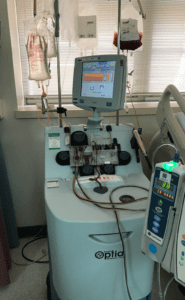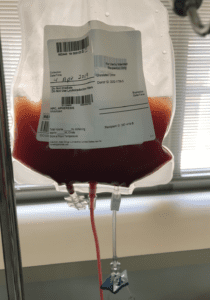Picture this- your child has been diagnosed with cancer. You’d do anything to help cure them, right? Now picture this- a complete stranger with cancer has a DNA profile almost identical to yours, and the only cure is for you to donate blood stem cells. Would you do it?
My husband recently was faced with this question.
A few years ago, my mother-in-law asked us to sign up on the Be The Match national bone marrow registry instead of giving physical gifts for Christmas. So after filling out a quick form on the Be The Match website, we were sent DNA test kits to swab our cheeks and mail back.
I’m sure she never thought one of us would be matched with a complete stranger. (I mean, there’s a 1 in 430 chance of being matched and donating!)
But there we were, a few months ago. My husband got the call. His genetic DNA closely matched someone in need of bone marrow, and he could literally save their life.
He said yes.
Fast forward a few months after receiving the initial call to donate. My husband underwent a full physical, multiple blood draws, and many long phone conversations about his health history with his Be The Match representative to ensure he was a perfect match for the recipient, and that he was 100% sure he wanted to go through with the procedure.
The most common question he receives when he tells people about his experience is- doesn’t that hurt, a LOT?
Yes and no. Unlike how bone marrow donation is portrayed in shows as a painful procedure where marrow is extracted from your hip while you’re under anesthesia, his donation (and the most common donation type!) is called a peripheral blood stem cells (PBSC) donation. Donating PBSC is a non-surgical procedure. For five days before his donation, he was given injections of filgrastim, a medication that increased the number of blood-forming cells in his bloodstream. On donation day, blood was removed through a needle in one arm and passed through a pheresis machine that separated out the blood-forming cells (PBSC). The remaining blood was returned to him through his other arm. The actual procedure wasn’t overly painful for him, although he wasn’t allowed to get up from the bed once they started. My husband reported that the most uncomfortable step was the filgrastim injections. Since his bones were producing more blood-forming cells, he had pretty bad bone pain. From an outsider’s perspective, the procedure itself looked much like an extended blood donation.


After my husband’s procedure was over, a courier picked up the donation, (what looked like a pale yellow liquid, then diluted blood) and hand delivered it to the recipient to be infused (transplanted) the next day. The week-long bone pain subsided 24 hours after the donation, and he was almost back to his normal self.
So now you’ve read the low-down on bone marrow donation, are you more willing to sign up to potentially save a life?










